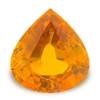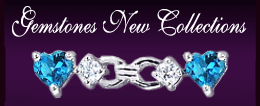Glittering Stones >> Cutting Of Gemstones
Cutting Of Gemstones
There are four basic way and style of gem cutting: tumbling, Cabochon Cutting, faceting and carving. Including there is a number of ways to assemble gem stones into mosaic like patterns, (called intarsia,) boxes, etc.
Gems are generally cut to bring out their natural color and its brilliancy and also to remove flaws. In the cabochon cut, the upper surface of the stone is smoothed and then rounded into a simple curve of any degree of convexity; the lower surface could be concave, convex, or flat. All the remaining cuts have flat facets. In the table cut, the facets of the natural octahedron of the diamond that are ground to smoothness and polished; one facet, the table, is ground much larger than any other and always made the top of the gem, while the opposite facet, the culet, is left quite small. The rose cut consists of a flat base and (usually) 26 triangular facets—resembling a cabochon with facets.
Tumbling
The simplest form of gem cutting is tumbling. This is where the rough material is put in to revolving barrel with its abrasives. Progressively finer abrasives are used, until a polish is then obtained. This process closely resembles what happens to rocks in a stream and on the beach, except that the level of polish is much higher.
Tumbling is ideal also for children. It is easy; takes a minimum of equipment, (approx. $150,) and the results are sensational! There are a number of inexpensive settings also available so the tumbled gem stones can be turned into jewelry. These make wonderful, homemade gifts.
Cabochon Cutting
Cutting en cabochon, and as it is more commonly known, cutting cabs, is probably it is the most common form of gem cutting. Cabs are gems that are cut with a flat bottom and a curved or then domed top. If you can envision an opal or a piece of turquoise, you are looking at a cab.
Cabs have distinct resale value, based on the material they are cut from and its cutting could be profitable. This makes for an excellent, indoor hobby. It is especially enjoyable if you are cutting materials you have found on your own.
It only takes a little practice to become very proficient and is something almost everyone can learn to do well. Good equipment would cost in the neighborhood of $1,000. A word of warning though, this could be highly addictive!
Faceting
Faceting is the style of cutting, which has the greatest profit potential. If you could envision a diamond, you are looking at a faceted gem. The surface of a diamond is fully covered with several geometrically arranged, flat surfaces. Each of these flat surfaces is known as facet. The gem is faceted, by a faceted on a faceting machine. This is also where we get the expression, "a multifaceted question."
The purpose of faceting is actually to bring out the brilliance of a gem. That is where the light entering the stone is reflected off the bottom facets and then returned to the viewer. Brilliance may not be confused with fire, which is the multicolored flash you see coming out of diamonds and some other gems.
Faceting is one of those art forms that you can become good at with a minimum of experience, but also one where you will never run out of new challenges. Nor does it require any esoteric "artistic" sense. Machinists, engineers and people good at math often excel in faceting.
Carving
Carving is the most challenging of the lapidary arts and there are very few recognized experts in the field. To be successful, one should have a distinctive artistic sense and a thorough understanding of the principles of lapidary. Unlike working in its wood and metal, the materials present definite limits as to what can be done.
There are several types of carving. One of the best known is cameo. These are usually cut from sea shells and agates, but they can be carved from almost any material.
NOVEMBER BIRTHSTONE - CITRINE

COMMEMORATIVE EVENT - 13th Anniversary
KEYWORDS - Success, Abundance, Personal Power
ALSO KNOWN AS - Merchant's stone, Success stone
COLORS - Pale yellow to brown
OCCURRENCE - Brazil
COLOR ZONING - Tiger stripes or Zebra stripes


